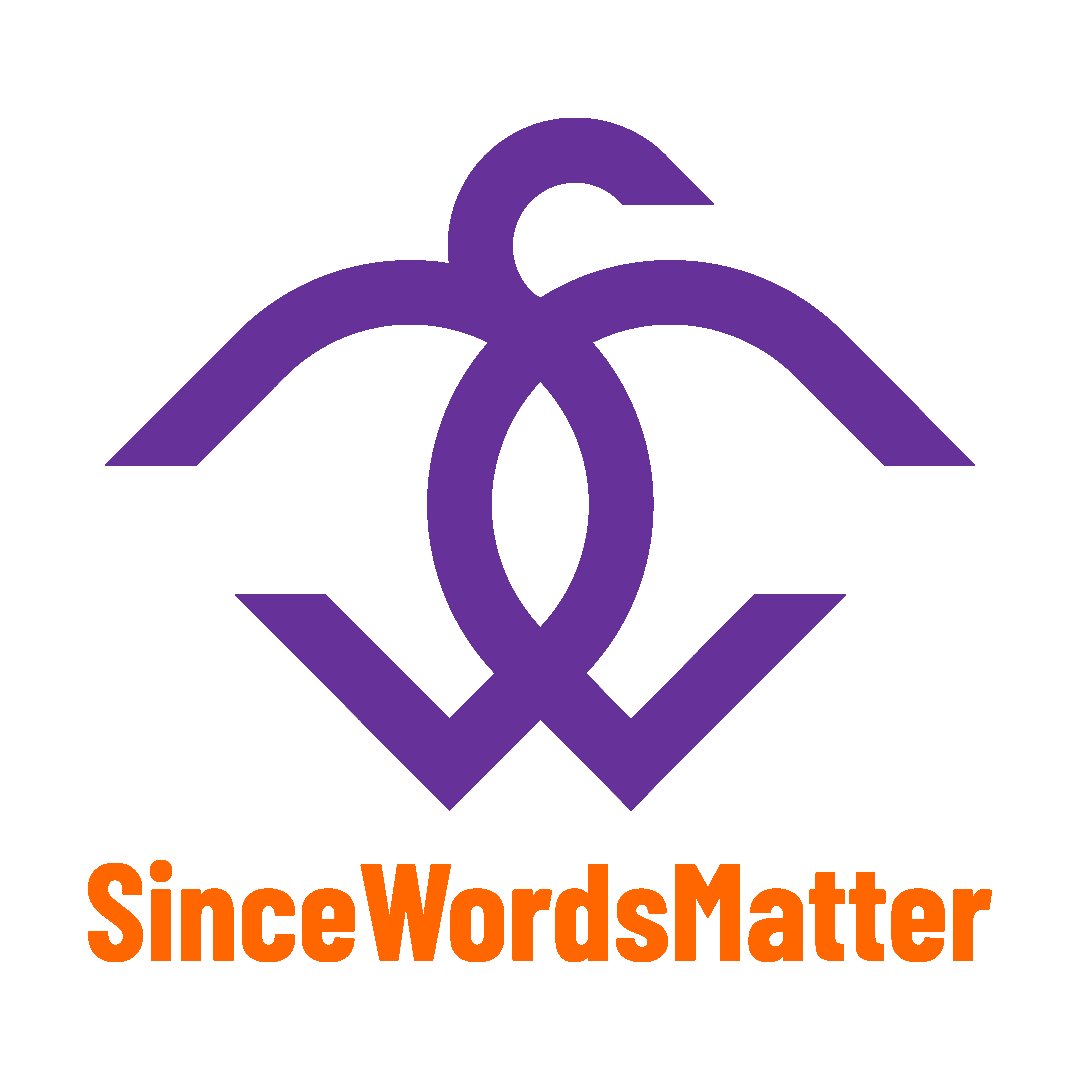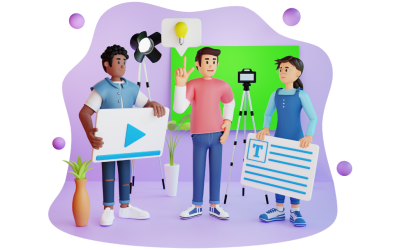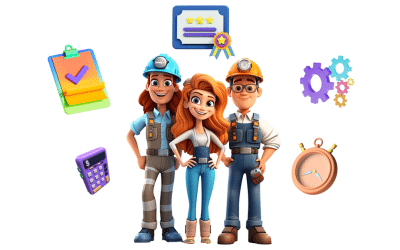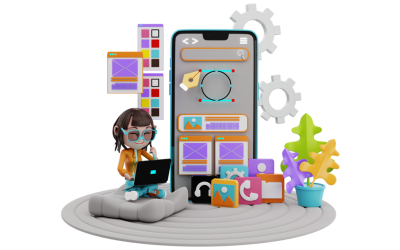Last Update on:

In our increasingly interconnected world, where communication spans diverse cultures and global interactions become the norm rather than the exception, the importance of translation cannot be overstated. Translation is now the linchpin connecting people, businesses, and nations, facilitating the exchange of ideas, information, and culture. The pivotal role of translation sheds light on the soaring demand for skilled translators across various industries, and the purpose of this blog post: to provide a comprehensive, step-by-step guide on how to become a good translator.
Whether you’re passionate about languages, seeking a flexible career path, or simply intrigued by the power of words, embarking on a journey to become a proficient translator can open up a world of opportunities. SinceWordsMatter, translation is far more than simply converting words from one language to another. A skilled translator can bridge cultures, convey nuanced meanings, and capture the essence of the original text in a new linguistic landscape.
In this blog post, we’ll delve into the fundamental skills and strategies that form the bedrock of a successful translation career, from understanding the basic principles of translation to harnessing technology and building a strong professional network. As we delve deeper into the world of translation, we’ll discover the diverse types of translation. Understanding the characteristics and requirements of various translation niches will help you identify your strengths and interests, enabling you to specialize in a field that resonates with you. So, get ready to explore the vast landscape of how to become a good translator!
Table of Contents
- Improving Cultural Competence
- Specializing in a Niche
- Building a Strong Foundation in Grammar and Style
- Leveraging Technology and Tools
- Final Thoughts on the Mastering Translation
Improving Cultural Competence
As the need for effective cross-cultural communication continues to grow, so does the demand for skilled translators across a myriad of industries. Cross-cultural translation is not merely about converting words from one language to another; it also requires a deep understanding of the cultural nuances and context behind the text. Cultural competence is vital in becoming a good translator, as it allows for accurate and effective communication between languages and cultures.
Companies expanding into new markets require translators to adapt marketing materials, legal documents, and product information to resonate with local audiences. This not only ensures accurate communication but also helps businesses navigate the complex web of cultural intricacies, making their products and services more accessible and appealing to diverse markets. In this section, we’ll explain the importance of cultural understanding and offer methods to learn cultural nuances and master cross-cultural communication skills.
A. Importance of Cultural Understanding in Translation
Cultural understanding is paramount in translation because language and culture are intricately intertwined. SinceWordsMatter, translators must go beyond the surface meaning of words and grasp the cultural context embedded within a text. The first reason is that understanding the cultural background, values, and beliefs associated with the source and target languages is required for accurately conveying the text’s intended meaning.
The second reason is that different cultures uniquely express ideas, concepts, and emotions. Translators need to be aware of these differences and adapt the translation accordingly. Translating a text without considering its cultural context can lead to misinterpretation or misrepresentation. Cultural understanding allows for appropriate tone, style, and language adjustments to ensure the translated text resonates with the target audience.
Thirdly, cultural sensitivity is crucial in translation to avoid inadvertently causing offense or misunderstanding. Knowledge of cultural customs, taboos, and sensibilities allows translators to navigate potential pitfalls and produce culturally appropriate and respectful translations. Now that you know the significance of cultural competence, let’s move on to techniques for improving it.
B. Researching Cultural Nuances and Idioms
Cultural nuances include subtle expressions, gestures, and specific vocabulary that may not have direct equivalents in another language. Translators must invest time and effort in researching cultural nuances and idioms to improve cultural competence. For example, translating idioms requires both linguistic proficiency and cultural insight. Otherwise, a translator may choose an inappropriate equivalent or fail to capture the intended metaphorical meaning, consequently losing the original message’s impact or humor. Here are some strategies to enhance this aspect:
1. Extensive Reading:
Read extensively about the cultures associated with both the source and target languages. This includes literature, history, news, and other relevant materials. By immersing yourself in the cultural context, you can gain insights into the values, traditions, and social dynamics that shape the language and its usage.
2. Cultural Research:
Conduct in-depth research on specific cultural aspects, such as customs, traditions, festivals, and societal norms. Familiarize yourself with the etiquette, gestures, and body language prevalent in the target culture. This knowledge will help you accurately translate texts that contain culturally specific references.
3. Collaborate with Native Speakers:
Engage in conversations and collaborations with native speakers of the target language and culture. Native speakers can provide invaluable insights into cultural nuances, idiomatic expressions, and subtle linguistic cues. Their feedback and guidance can significantly enhance your understanding of the target culture.
C. Building Cross-Cultural Communication Skills
Cross-cultural communication skills include a deeper understanding of historical events, social customs, and cultural references that may be embedded in the source language. Immersing oneself in different cultures through travel, cultural events, or interactions with people from diverse backgrounds provides firsthand exposure to different communication styles, customs, and perspectives. This exposure facilitates the development of empathy and sensitivity towards other cultures. By honing these skills, translators can accurately interpret and convey the intended message. Here are some practical approaches to improve these skills:
1. Active Listening and Observation:
By actively listening to native speakers and paying attention to their pronunciation, intonation, and use of language, you can develop a better understanding of the cultural nuances embedded in the spoken word. Observing non-verbal cues, body language, and social interactions also provide valuable insights into the cultural context. This will help you understand the language, cultural subtext, and implied meanings.
2. Engage in Intercultural Experiences:
Actively seek out opportunities to interact with people from different cultures. For example, participate in cultural events, attend language exchange programs, or even travel to countries where the target language is spoken. Immersing yourself in diverse cultural environments enhances your ability to navigate and understand different perspectives and communication styles.
3. Develop Empathy:
Cultivate empathy towards different cultures by putting yourself in the shoes of others. Understand that cultural practices and beliefs may differ from your own, and approach them with an open mind. Empathy allows translators to understand and share the feelings, experiences, and perspectives of others, finally contributing to more accurate and culturally sensitive translations.
4. Seek Feedback:
Regularly seek feedback from native speakers, cultural consultants, or translation professionals familiar with the target culture. Their feedback can provide valuable insights into translations’ accuracy, appropriateness, and cultural nuances. Consequently, you can identify areas for improvement, learn from your mistakes, and refine your skills. This iterative process of seeking feedback allows you to continually enhance your cross-cultural communication abilities and deliver high-quality translations that meet the target audience’s expectations.
Specializing in a Niche
Translation is a vast field, offering numerous opportunities for language professionals to specialize in specific niches. By consistently delivering exceptional translations within a particular niche, translators can differentiate themselves from generalists and attract a dedicated client base. Building a strong reputation within a niche enhances professional credibility, increases referral opportunities, and opens doors to higher-paying translation projects.
This specialized approach proves to be a win-win, as clients appreciate the nuanced understanding that comes from expertise in their industry. You can become a highly skilled and sought-after translator in your chosen field by identifying your interests and strengths, exploring different translation niches, and gaining specialized knowledge and vocabulary. Want to know how? Continue reading.
A. Identifying Personal Interests and Strengths
When considering specialization as a translator, it is essential to identify your interests and strengths. When you work in a field you are genuinely interested in, you are more likely to invest time and effort into deepening your knowledge and staying updated with industry trends. Personal interests and strengths provide the motivation and drive to excel in a specific niche and produce high-quality translations. Here are a few steps to help you identify your interests and strengths:
1. Self-Reflection:
Take the time to reflect on your personal interests, hobbies, and areas of expertise. Consider the subjects that captivate and inspire you. Make a list of them and point out the positive and negative feelings you get from working in each field. Choose the fields for which you find the most positive and the least negative feelings. Identifying your passions will help you determine the areas where you will most likely excel as a translator.
2. Assessing Language Skills:
Evaluate your language skills and identify the languages in which you are most proficient. Assess your command over specific language pairs and determine which combinations provide the greatest potential for specialization. Remember that you potentially have more skills in your native tongue. Include it in any language pair you aim to work in to increase your chance of being selected by the clients, too.
3. Analyzing Personal Strengths:
Consider your unique skills and strengths as a translator. Are you detail-oriented, analytical, or creative? Assessing your strengths will help you choose a niche that aligns with your natural abilities and allows you to excel in your work. After recognizing your interests and strengths, you need to match them with the available opportunities in the translation world. We’ll discover how to do so in the next section.
B. Exploring Different Translation Niches
Exploring different translation niches allows translators to gain exposure to various industries and understand their unique language requirements. Niche areas include medical, legal, technical, financial, and literary translation. From literary translations that bring works of art to life to technical translations that require precision and accuracy and legal translations that demand meticulous attention to detail, each type presents unique challenges and rewards.
By exploring different niches, translators can identify the ones that resonate with them the most and align with their skills and career goals. This exploration also helps expand one’s horizons, foster versatility, and develop diverse translation skills. The translation industry is so vast that you can surely find more than one niche that matches you; however, here are some common niches to consider first:
1. Medical Translation:
Medical translation focuses on translating documents related to healthcare, pharmaceuticals, medical research, and patient records. This niche requires a strong understanding of medical terminology, as well as knowledge of regulatory requirements and ethical considerations in the medical field. You can fit in this niche well if you want to learn about cutting-edge new medical treatments sooner than most people.
2. Legal Translation:
Legal translation involves translating legal documents such as contracts, court transcripts, and legislation. It requires an in-depth understanding of legal terminology, different legal systems, and the ability to navigate complex legal concepts accurately. Interest in Latin expressions and the power to take no sides may lead a translator to work in the legal niche.
3. Technical Translation:
Technical translation deals with translating technical documents such as user manuals, engineering specifications, and scientific papers. This niche requires a strong background in the relevant technical field, as well as a deep understanding of specialized terminology and concepts. Similar to medical translators, technical translators may also find out about new technological advancements sooner than others.
4. Business Translation:
Business translation encompasses translating documents related to the business world, such as marketing materials, financial reports, and corporate communications. It requires a solid understanding of business terminology, industry trends, resourcefulness, and excellent research skills. It’s worth mentioning that business translation often requires you to quickly gather information and stay updated on industry-specific terminology and trends. In the next part, we’ll talk about how to do so.
Read more about different types of translation.
C. Gaining Specialized Knowledge and Vocabulary
By immersing yourself in a particular niche, you can develop expertise, stay updated with industry developments, and build a solid foundation of specialized knowledge. This deep understanding enables you to produce accurate and contextually appropriate translations by knowing the industry-specific jargon and concepts that ensure the original message’s integrity. Here are some strategies to enhance your expertise:
1. Continuous Learning:
Stay updated with the latest developments in your chosen niche by actively seeking learning opportunities. Attend industry conferences, webinars, and workshops to expand your knowledge and keep abreast of changes and trends in your specialized field. Following the latest news of your chosen field is also helpful.
2. Subject-Matter Research:
Conduct thorough research on the topics relevant to your niche. Read books, scholarly articles, and industry publications to deepen your understanding of the subject matter. Familiarize yourself with your specialized field’s key concepts, terminology, and current debates. Besides, collaborating with experts on translation projects in your niche can enhance your language comprehension and prowess.
3. Networking:
Connect with professionals working in your niche. Engage in discussions with subject-matter experts, join professional associations, and participate in online forums and communities. Networking allows you to exchange ideas, share knowledge, and stay connected with the latest developments in your field. You can join work-specific platforms like LinkedIn or Proz.com, which focuses on the translation industry.
4. Specialized Glossaries and Resources:
Curate specialized glossaries and resources specific to your niche. Create your own database of terminology, idioms, and phrases to refer to during translation projects. This will help you maintain consistency and accuracy in your specialized translations. In addition, some grammatical structures might have specific meanings in your chosen niche that you must look for. The next section discusses the role of grammar and style expertise in becoming a good translator.
Building a Strong Foundation in Grammar and Style
Building a strong foundation in grammar and style is essential for becoming a good translator. A solid understanding of grammar allows translators to accurately analyze and interpret the structure and meaning of the source text. However, proficiency in grammar rules helps translators identify syntactic patterns, sentence structures, and grammatical relationships, guaranteeing that the translated text maintains clarity and coherence.
On the other hand, applying the stylistic conventions of the target language produces translations that are not only linguistically accurate but also read smoothly and professionally. Style encompasses elements such as tone, register, and appropriate word choice. Translators with a strong foundation in style can effectively adapt the source text’s tone and register to match the target audience’s expectations and cultural norms.
Moreover, translators encounter various linguistic nuances, idiomatic expressions, and cultural references that require careful consideration. With a strong grasp of grammar and style, translators can navigate these challenges effectively. This ability to make informed linguistic decisions enhances the quality and authenticity of the translated text. You can follow the guidelines below to build a strong foundation in grammar and style.
A. Reviewing Grammar Rules in Both Source and Target Languages
Each language has unique grammar rules, sentence structures, and idiomatic expressions. By familiarizing themselves with these intricacies, translators can ensure that their translations read smoothly and sound natural to the target audience. In addition, it helps avoid awkward phrasing or incorrect grammar that might confuse or mislead readers.
Furthermore, sometimes, a source text may contain grammatical errors or inconsistencies. By having a solid understanding of grammar in both languages, translators can identify and rectify such issues, making necessary adjustments to ensure clarity and coherence in the translation. Below are some recommendations on how to review grammar rules in both source and target languages:
1. Language Courses and Classes:
Taking language courses or attending classes focused on grammar in both the source and target languages can provide a structured approach to reviewing grammar rules. These courses often cover various aspects of grammar, including syntax, verb conjugation, sentence structure, and grammatical nuances. Engaging in formal language education can help refresh and reinforce the translator’s knowledge of grammar rules.
2. Grammar Books and Resources:
Utilizing grammar books, reference guides, and online resources dedicated to the grammar of both the source and target languages can be an effective method of reviewing grammar rules. These resources provide comprehensive explanations, examples, and exercises that allow translators to deepen their understanding of grammatical concepts and rules. They can also help translators refresh their knowledge and discover new or overlooked grammar rules.
3. Practice and Translation Exercises:
Engaging in regular practice and translation exercises is an active way to review grammar rules. Translators can create or find texts in the source language and practice translating them into the target language, paying close attention to grammatical structures and rules. This hands-on approach allows translators to apply grammar rules practically, identify improvement areas, and refine their translation skills.
4. Peer Feedback and Collaboration:
Joining translator communities, participating in language exchange programs, or forming study groups with fellow translators can provide opportunities for constructive feedback and discussions focused on grammar. Through peer feedback and collaboration, translators can identify and rectify any grammar-related issues in their translations, as well as learn from the experiences and perspectives of others. Below are some tips for developing a keen sense of style and tone.
B. Developing a Keen Sense of Style and Tone
A good translator understands the author’s voice and strives to replicate it in the target language. Moreover, each translation genre has its own style and tone requirements. Besides, style and tone are closely tied to cultural nuances. By developing a versatile understanding of different writing styles, translators can adapt their translations to suit the specific genre and target audience. Here’s how to develop a keen sense of style and tone:
1. Read Extensively in Both the Source and Target Languages:
Immersing oneself in a wide range of literature, articles, and texts in both languages allows the translator to absorb different writing styles and tones. By exploring various genres and authors, they can develop a broader understanding of how language is used to convey different moods, attitudes, and intentions.
2. Study the Cultural Context:
As mentioned above, style and tone are closely tied to the cultural context in which a language operates. Translators should familiarize themselves with the cultural nuances, social conventions, and historical background of both the source and target languages. This knowledge enables them to adapt their translations in a way that captures the appropriate tone and resonates with the target audience.
3. Practice Writing in Different Styles and Tones:
Translators can enhance their skills by practicing writing in various styles and tones. They can attempt to mimic the voices of different authors or experiment with different registers, from formal to informal, academic to conversational. Engaging in such exercises helps them gain a better understanding of how language choices impact the overall style and tone of a text.
4. Seek Feedback and Learn from Experienced Translators:
Collaborating with experienced translators and seeking their feedback can be immensely valuable. Their insights and guidance help translators refine their comprehension of style and tone. By analyzing and discussing translated texts, attending workshops or conferences, and participating in translation communities, translators can benefit from their peers’ collective knowledge and expertise. Style guides and references are also beneficial, which we’ll discuss in the next section.
C. Utilizing Style Guides and Reference Materials
Dictionaries, glossaries, and grammar books provide valuable information on grammar rules, idiomatic expressions, technical terminology, and other linguistic aspects. Utilizing these reference materials facilitates accurate translation and helps resolve language-related queries. Besides, translators should engage in continuous learning and stay updated with changes in grammar and style since language is dynamic, and new linguistic trends emerge over time.
Style guides show language usage, punctuation, formatting, and other stylistic elements. They help maintain consistency within one or across multiple projects. Translators should also familiarize themselves with industry-standard style guides or follow client-specific guidelines to ensure consistency and meet client expectations. Here are some ways in which translators can effectively use style guides and reference materials to build a strong foundation in grammar and style:
1. Research and Verify Facts:
Reference materials, such as encyclopedias, academic journals, and reputable websites, can serve as valuable sources of information. Translators should utilize these resources to research and verify facts, figures, historical events, and other contextual information related to the source text. This ensures that the translated text is accurate, reliable, and well-informed.
2. Consult Specialized Dictionaries and Glossaries:
Translators should make use of specialized dictionaries and glossaries that are focused on their subject matter or industry. These resources provide accurate and reliable technical terms, jargon, and industry-specific terminology translations. They help ensure that the translator uses the appropriate terminology and maintains accuracy in the translation.
3. Create and Maintain a Personal Glossary:
Translators can develop their own glossaries, compiling a list of frequently used terms, idioms, and phrases in both the source and target languages. This personalized reference material serves as a quick and reliable resource while translating. It helps maintain consistency and avoids ambiguity in terminology throughout different translation projects.
4. Get Familiarized with Style Guides:
Translators should familiarize themselves with widely used style guides, such as The Chicago Manual of Style or the Associated Press (AP) Stylebook. These guides instruct on punctuation, capitalization, abbreviations, and other grammatical conventions. Translators can maintain consistency and professionalism by adhering to a recognized style guide. Some translation tools can also help translators use consistent style guides. Read on to learn the tools necessary for becoming a good translator.
Leveraging Technology and Tools
Today’s translation industry is powered by an array of tools and software that can streamline the translation process, assist in terminology management, and facilitate collaboration with clients and colleagues. Translation tools and software, such as CAT tools and machine translation, can significantly enhance productivity and accuracy. Staying updated on industry advancements enables translators to adopt the latest tools and techniques, offering a competitive advantage.
By integrating technology effectively, translators can navigate the evolving landscape of the translation industry and deliver exceptional results to their clients. However, it’s important to remember that while technology can be a valuable ally, it cannot replace the human touch and the nuanced understanding that a skilled translator brings to the table. This section will first overview the existing translation tools and software. Then, we’ll say how you can stay updated on these advancements and integrate them to enhance efficiency without compromising quality.
A. Overview of Translation Tools and Software
Translation tools and software have revolutionized the way translators work, providing them with powerful resources to improve productivity, consistency, and accuracy. From CAT tools that leverage translation memories to machine translation systems that offer initial translations, these tools support and enhance the skills of human translators. Embracing these technologies allows translators to meet the demands of a fast-paced industry while delivering high-quality translations to clients and readers. Following is an overview of some key tools and software:
1. Computer-Assisted Translation (CAT) Tools:
CAT tools, such as SDL Trados, MemoQ, and OmegaT, are designed to assist translators in their work. These tools enable translators to create translation memories (TM), which store previously translated text segments. When encountering similar or identical phrases, sentences, or paragraphs, the CAT tool automatically suggests or retrieves the corresponding translation from the TM, saving time and effort. Additionally, CAT tools offer features such as terminology management, concordance search, and quality assurance checks, ensuring accuracy and consistency throughout the translation process.
2. Machine Translation (MT):
Machine Translation, exemplified by Google Translate and DeepL, relies on artificial intelligence to translate text automatically. While it is not a replacement for human translation, MT can be used as a starting point or for reference. MT systems can be general-purpose or specialized for specific domains, and they continue to improve through neural networks and deep learning techniques.
3. Project Management Tools:
Project management tools streamline the workflow and ensure efficient project management by providing a centralized platform for task management, file sharing, and deadline tracking. The communication features within these tools facilitate seamless collaboration and effective communication among translators, clients, and other stakeholders. Embracing project management tools empowers translators to optimize their productivity, maintain clarity and transparency, and deliver high-quality translations within deadlines.
4. Terminology Management Tools:
Terminology management tools like MultiTerm and tbxManager allow translators to create and maintain consistent glossaries and terminology databases. These tools ensure that translators use the correct terminology throughout their translations, enhancing accuracy and consistency. Since the translation industry is constantly evolving, translators must stay updated on the new technologies and tools emerging regularly. The next part explains how.
B. Staying Updated on Industry Advancements
New tools and technologies often aim to streamline translation workflows, automate repetitive tasks, and enhance productivity. Clients increasingly expect translators to be technologically savvy and proficient in using the latest tools. If updated on industry advancements, like the development of neural machine translation (NMT), translators can differentiate themselves from their peers and offer added value to clients, thus gaining a competitive edge in the market. Below are some strategies that translators can employ to stay updated on Industry advancements:
1. Continuous Professional Development:
Engaging in continuous learning and professional development is essential. Translators can attend industry conferences, workshops, and seminars to gain insights into the latest advancements, trends, and best practices. These events often feature expert speakers and provide networking and knowledge-sharing opportunities. Translators can also join professional associations and networks to keep abreast of industry developments.
2. Follow Industry Publications and Blogs:
Subscribing to industry publications can provide valuable updates on translation technology, industry trends, and new techniques. Translators can follow renowned translation blogs, language-specific publications, and online platforms dedicated to translation and localization. These sources often share articles, case studies, and interviews with industry experts, offering insights and tips for professional growth.
3. Embrace Technology and Translation Tools:
Keeping up with advancements in translation technology is vital. Translators should familiarize themselves with the latest translation tools, CAT software, and machine translation systems. Following technology blogs and attending webinars or training sessions on new translation tools and software can help translators stay updated on the latest features and functionalities. However, integrating these tools and technologies is more important than learning about them. Thus, the next part is dedicated to this subject.
C. Integrating Technology to Enhance Efficiency Without Compromising Quality
While technology can greatly enhance a translator’s efficiency, it is essential to strike a balance to ensure that quality is not compromised. For instance, machine translation (MT) systems have made significant advancements but are not perfect substitutes for human translators. Therefore, an overreliance on MT without proper human oversight can compromise the quality of translations and fail to deliver the necessary accuracy and precision.
Read more about why human translators are still better than machine translation.
While technology tools offer quality assurance features, their effectiveness relies on proper utilization and knowledge. Additionally, technology can introduce its own set of errors or issues, such as incorrect segmentation, formatting problems, or incorrect handling of special characters. Without diligent quality assurance practices, the use of technology in the translation process may inadvertently compromise the overall quality of the final deliverables.
Besides, technology tools, such as computer-assisted translation (CAT) software, require customization and adaptation to the specific needs of translators and their projects. If these tools are not properly configured, they may hinder efficiency rather than enhance it. Insufficient customization can lead to cumbersome workflows, time-consuming adjustments, and limited integration with other tools or systems. Here’s how translators can integrate technology effectively:
1. Selecting the Right Tools:
A wide range of translation tools is available, and choosing the ones that align with your specific needs and workflows is crucial. Take the time to research and test different tools to find the ones that best suit your requirements and enhance your efficiency without sacrificing quality. You can also take advantage of the comparisons made by other professional users, which are widely available on YouTube.
2. Training and Familiarity:
To effectively leverage technology, translators should invest time in training and becoming familiar with the tools they use. Many tools offer tutorials, webinars, and user communities where translators can learn best practices and exchange knowledge with other users. Proficiency in using the tools allows translators to maximize their benefits and minimize potential pitfalls.
3. Quality Assurance:
While technology can assist in various aspects of translation, it is essential to maintain a critical eye and perform thorough quality assurance checks. Translators should review and edit machine translations, verify the accuracy of CAT tool suggestions, and ensure that the final translation meets the required standards of quality and accuracy.
Final Thoughts on the Mastering Translation
Mastering the art of translation is a rewarding journey that goes beyond language proficiency. It requires a deep understanding of culture, context, and effective communication. As you embark on this journey, keep the following in mind:
1. Translating Is an Art:
Translation is not just about converting words from one language to another. It is about preserving meaning, capturing nuances, and conveying the essence of the original text. It requires creativity, adaptability, and a deep respect for languages.
2. Impacting Lives:
Translators have the power to bridge gaps, facilitate understanding, and connect people from different cultures. Your work can have a profound impact on individuals, businesses, and society as a whole. Embrace the responsibility that comes with this role and strive to make a positive difference through your translations.
3. Enjoy the Journey:
Becoming a good translator is a process that takes time. Embrace the challenges, celebrate your successes, and enjoy the journey of continuous improvement. Every translation you undertake is an opportunity to refine your skills, expand your knowledge, and contribute to your personal and professional growth.
Are you a translator who has been following and utilizing the abovementioned points? If so, we invite you to join our company! We are looking for talented translators like you who are dedicated to their craft and committed to delivering exceptional linguistic solutions. Join our team and be a part of a dynamic and supportive community where your skills will be valued, your growth will be nurtured, and you’ll have the opportunity to work on diverse and exciting projects.

Take the next step in your translation career, and join us today.
Apply now and let your expertise shine!






